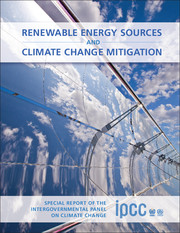 Renewable Energy Sources and Climate Change Mitigation
Renewable Energy Sources and Climate Change Mitigation Book contents
- Frontmatter
- Contents
- Section I
- Section II
- Section III
- Chapter 1 Renewable Energy and Climate Change
- Chapter 2 Bioenergy
- Chapter 3 Direct Solar Energy
- Chapter 4 Geothermal Energy
- Chapter 5 Hydropower
- Chapter 6 Ocean Energy
- Chapter 7 Wind Energy
- Chapter 8 Integration of Renewable Energy into Present and Future Energy Systems
- Chapter 9 Renewable Energy in the Context of Sustainable Development
- Chapter 10 Mitigation Potential and Costs
- Chapter 11 Policy, Financing and Implementation
- Section IV
- Index
- References
Chapter 9 - Renewable Energy in the Context of Sustainable Development
Published online by Cambridge University Press: 05 December 2011
- Frontmatter
- Contents
- Section I
- Section II
- Section III
- Chapter 1 Renewable Energy and Climate Change
- Chapter 2 Bioenergy
- Chapter 3 Direct Solar Energy
- Chapter 4 Geothermal Energy
- Chapter 5 Hydropower
- Chapter 6 Ocean Energy
- Chapter 7 Wind Energy
- Chapter 8 Integration of Renewable Energy into Present and Future Energy Systems
- Chapter 9 Renewable Energy in the Context of Sustainable Development
- Chapter 10 Mitigation Potential and Costs
- Chapter 11 Policy, Financing and Implementation
- Section IV
- Index
- References
Summary
Executive Summary
Historically, economic development has been strongly correlated with increasing energy use and growth of greenhouse gas (GHG) emissions. Renewable energy (RE) can help decouple that correlation, contributing to sustainable development (SD). In addition, RE offers the opportunity to improve access to modern energy services for the poorest members of society, which is crucial for the achievement of any single of the eight Millennium Development Goals.
Theoretical concepts of SD can provide useful frameworks to assess the interactions between SD and RE. SD addresses concerns about relationships between human society and nature. Traditionally, SD has been framed in the three-pillar model—Economy, Ecology, and Society—allowing a schematic categorization of development goals, with the three pillars being interdependent and mutually reinforcing. Within another conceptual framework, SD can be oriented along a continuum between the two paradigms of weak sustainability and strong sustainability. The two paradigms differ in assumptions about the substitutability of natural and human-made capital. RE can contribute to the development goals of the three-pillar model and can be assessed in terms of both weak and strong SD, since RE utilization is defined as sustaining natural capital as long as its resource use does not reduce the potential for future harvest.
- Type
- Chapter
- Information
- Renewable Energy Sources and Climate Change MitigationSpecial Report of the Intergovernmental Panel on Climate Change, pp. 707 - 790Publisher: Cambridge University PressPrint publication year: 2011
References
- 45
- Cited by


